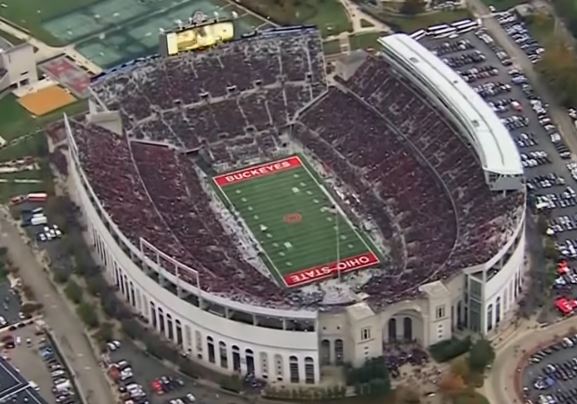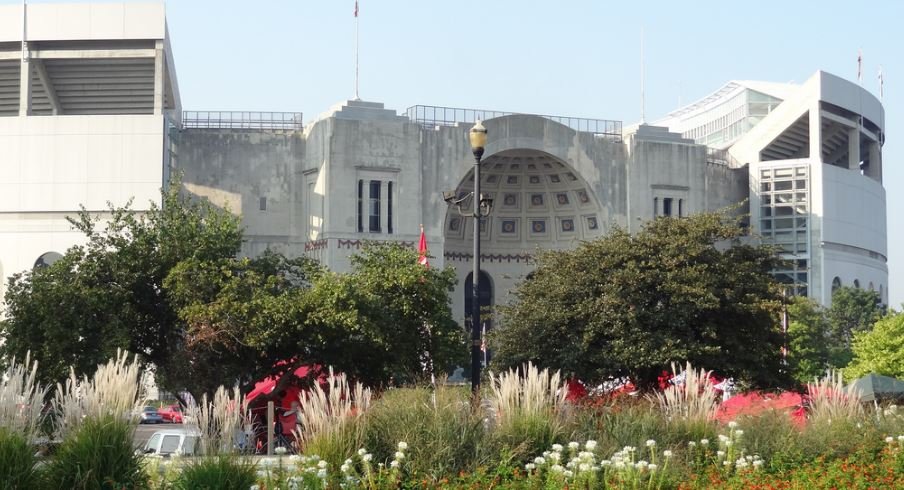About a week ago, my fellow teachers and I went to Ohio State to take our students on a tour of an institution that, whether they know it or not, has possibly the largest socioeconomic impact on their lives as residents of Columbus (at least until they fall under the thrall of Jeff Bezos and swear an oath of fealty to Amazon.com).
Anyway, their favorite part of my ersatz tour that I was making up as I went was probably when we strolled right on up to Ohio Stadium and I told them we'd be going inside.
"They usually leave some part of the gates open for whatever reason," I said (which is true). "We can probably just sneak in or whatever, I doubt anyone will care" (which is mostly true, but a more accurate statement would be "I don't care if I get yelled at for this"). "And besides, I know some people who work here" (which is just a blatant lie).
It turned out that we didn't need to sneak in anywhere, we just had to sign in with a friendly guy in a booth and promise not to screw around too much. I could promise that, but not on anyone's grave or a religious text or anything serious, so I decided to make our visit quick before a couple dozen teens got bored and destructive. That left us just enough time to make our way through the concourse and out into A-deck, and I got the real thrill of watching my students take in the enormity of Ohio Stadium for what was the first (and maybe only) time that most of them will see the inside in person.
To see the look on their faces as they looked around and did the mental calculus of transporting themselves to gameday was great. It reminded me of the first time that I ever attended a game in the Horseshoe, and how geeked I was to be in a stadium that sat twice as many people than were in my entire hometown.
Of course, it wasn't my first time in Ohio Stadium, or even my 25th. So instead of focusing on the grandeur of the thing, I was paying more attention to the concrete refurbishment on C-deck and the fact that the concourse still evokes the feeling of a dank Soviet-era bunker in the middle of Ukraine, even on a sunny day in spring.
And this is the central problem for Ohio State as it tries to keep up with the collective Joneses of the college football world: stadium size, once a resume-builder that in of itself was reason enough for someone to attend a game in your venue, is no longer nearly enough to sustain the revenues demanded in the 2010's. My students loved just being inside the stadium because, well, it's Ohio Stadium. But they also aren't going to be the ones buying tickets at 70-150 bucks a pop, and unfortunately for Ohio State, it's me who they have to woo back into the confines of one of the greatest sporting arenas on the planet.
For a while, though, being the gigantic home of the Buckeyes was all Ohio Stadium really needed.
A quick history lesson, which most of you already know: the concrete dried on Ohio Stadium way back in 1922 with a capacity of 66,210. Which, as far as I know, might've been the same as the population of the entire state of Ohio at that point. So that was pretty big in the Roaring Twenties, but over the years the size of the stadium kept pace with the rest of society, gradually increasing to hold almost 90 thousand patrons of the football arts by the 1990's, and then finally hit over 100k with a major renovation at the turn of the century.
Since then Ohio Stadium has fluctuated a few thousand seats here and there, but mostly kept its position as one of the top ten largest non-racing sports stadiums by capacity in the world. That's neat. It's also not enough.
For any stadium, really. From ESPN.com back in February:
College football game attendance continues to trend downward nationally, according to figures released by the NCAA on Tuesday.
FBS games (including neutral-site and bowl games) averaged 42,203 fans in 2017, a drop of 1,409 fans per game from 2016. It is the fourth consecutive year that FBS attendance has dropped year over year and, at 3.2 percent, it is the largest average drop since 1983.
The good news for the Big Ten is that it actually increased its average per-game attendance, but overall college football is starting to recognize the same thing that every other major sport already has: if you want people to come to your games and drop several hundred American dollars to sustain the likes of the freaking Cleveland Browns or Cincinnati Reds or INSERT RANDOM GARBAGE FRANCHISE HERE, the gameday experience had better be memorable. And not just in the Muni Lot.
TCU, for instance, just announced that they're dropping 100 million bucks on a stadium renovation, as is Missouri. Tennessee has a multi-year plan for Neyland Stadium that's going to run them a hilarious 340 million dollars. Boone Pickens Stadium at Oklahoma State is getting a ridiculous video board.
All of the above are being done in an effort to extend the life and the profitability of stadiums that have to justify their existence every year. For Ohio State, which is lucky enough to have a legacy of kicking ass, that wasn't a tough trick to pull off. But there have been games in recent years that have made me reconsider the invincibility of Ohio Stadium; there have been several times where certain sections have not filled up to expectations, and fans have trickled in during the 1st quarter as opposed to the more customary and polite five hours before kickoff to fully appreciate a marvel of engineering.

It's true that you have to squint to see this at Ohio State. The Buckeyes have been near or at the top in various attendance metrics since the dawn of time, and that hasn't changed in the last several years (and they even recently set a stadium record for attendance at a single game against Michigan in 2016). I doubt that you'll see large sections of the stadium being left bare unless whoever Urban's heir is turns out to be a complete dud, and I'm not claiming that attendance numbers are going to drop to Hoosier levels any time soon.
But this is all about preparing for the future, which begs the question: is Ohio State's administration doing enough to keep Ohio Stadium filled to capacity five, 10, or 15 years down the line?
I'm not convinced that they are. The Horseshoe is currently undergoing renovations, announced in 2016, that will:
- Restore and re-coat the 94-year-old concrete on C-deck;
- Upgrade power distribution systems for the east, west and south stands;
- Improve and upgrade B-deck to include better lighting, larger televisions, and improved sound system and better scoreboards (with three more transformers), which will improve the experience of fans with obstructed-view seats; and
- Renovate the premium seating area to consolidate the university suites into one University Suite and add 35 loge boxes and 12 luxury suites.
Again, neat! But is it enough? WiFi will (hopefully) be coming in 2019, but until then, the average fan's experience in the stadium won't change a whole hell of a lot overall. One small, pithy example to prove my point: TCF Bank Stadium, recently opened by the University of Minnesota, has somehow fit 113 restrooms into its edifice. Ohio Stadium, with almost twice the capacity at TCF Bank Stadium, has perhaps a third of that. Bigger TVs on B-deck are nice, but it's not going to make someone buy a ticket to a game if they're on the fence about it.
I'll finish by making the subtext here just plain text. Ohio Stadium, which is an incredible cathedral of college football with an enormously important history, will celebrate its 100th anniversary in just a few years. Eventually, as costs continue to rise and tepid crowds become more common, the powers that be at Ohio State will have to decide if it's even possible for Ohio Stadium to provide the kind of fan experience that people are beginning to demand from their sports teams.
I want Ohio Stadium to remain viable as a home for Buckeye football well into the future, but that's going to require investment in the form of increased fan amenities, a heavily renovated concourse, seat improvements, etc. that appeal to the average, dollar-spending fan who no longer has the same the kind of wide-eyed wonder my students had.


